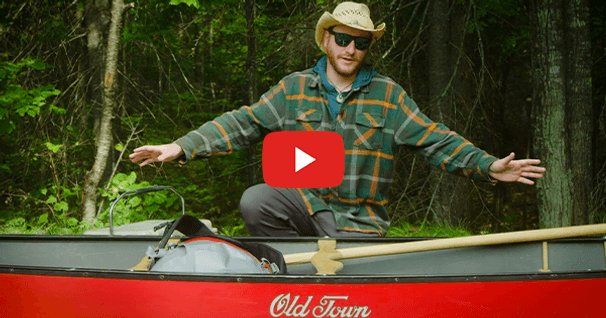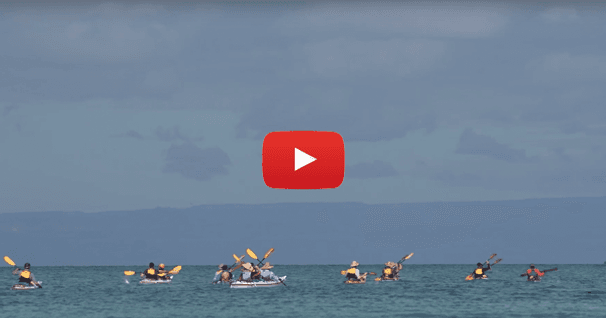The Boat Who Couldn't Sink
Flotation Devices for Capsize Recovery
Whether you paddle with a group or you enjoy paddling solo, there may come a time where you would need to do a solo recovery. Even if you can roll the day may come where your roll doesn't work for whatever reason. Following this "what if" reasoning, sooner or later you will be in the water and you will need to get back into your kayak. There are a number of alternative ways of doing this and many of them require some type of flotation device. I am often asked what is the best flotation device for solo recoveries. Therefore, I am going to focus this month's reflections on those flotation devices.
Floatation devices are used to add stability to an unsteady vessel, which can be your kayak when it is filled with water or when you are outside of the kayak trying to climb back in when it is upright. Once you get your backside into the seat and your feet and legs are in the cockpit the kayak usually feels more stable. The floatation device you choose to use should provide you with the stability you need while you get from the water back into your kayak. You should also consider the stability you will need when you are replacing the devices. Since you are depending on a floatation device for your balance, anytime you remove that device your balance is at risk so be prepared for the change.
Paddle floats are the flotation devices most seen and used by sea kayakers. Please don't interpret this statement as me saying they are the best. I have yet to find a technique or piece of equipment that doesn't have some pros and cons. As always, my philosophy is "you choose what works best for you", which means you need to get out and practice to see what works best and what doesn't. I personally like using an inflatable paddle float. I keep an inflatable one on my deck whenever I am on the water. Since I carry an inflatable paddle float I know that inflation time is a factor in my self-recovery process. Since I dress for immersion the extra time to inflate the float is not a concern. Some paddlers prefer a foam paddle float, especially in colder conditions, because there is no inflation time so the paddler can be out of the water sooner.
50 years of lightweight, maneuverable, high-performing kayaks.
Check out this interview with Tom Keane, Eddyline Kayaks Co-Owner, on their journey!
The paddle float (when inflated and put on the end of your paddle) provides the kayaker with a potential outrigger, which can add stability to their kayak as they re-enter. The paddle needs to be in the correct position and kept there during the re-entry process. This can be done manually or with deck rigging. If the kayaker keeps their balance point towards the float (outrigger) the recovery works well.
Regardless of the type of paddle float you use the weak part of this type of recovery is when you have to take the float off of the paddle blade. Maintaining your balance may be difficult when you do this because your hands are occupied replacing (and deflating in some cases) the float, which means your brace, is unavailable. This is a good time to use your one arm sculling brace. I will leave the discussion of where to store your recovery equipment for another article.
If the recovery is done correctly it works well.
- Common mistakes when doing a paddle float recovery are:
- Climbing on the paddle shaft to get onto the kayak rather than getting your weight onto the kayak and then putting your foot onto the paddle shaft. Climbing on the shaft can possibly break the shaft and/or sink the float.
- Leaning too far away from the float will cause a capsize.
- If you use your deck rigging to hold the paddle during re-entry don't lean out over the water when you slide the paddle back out from the rigging.
The debates of using an inflatable float vs. a foam float usually focus around inflation time, the amount of buoyancy, storage space and possible holes in air chambers. Regardless of the float there needs to be a method for keeping the float from prematurely coming off of the paddle blade during the recovery. If it is inflatable be sure there are two chambers for inflation. I prefer inflation valves that allow me one hand operation. There is also a paddle float that has a pouch that fills with water so it provides flotation and some counter balance if you were to lean the wrong way.
Sea Wings (Sponsons) are two inflatable floats that connect onto the sides of your kayak by the cockpit. The idea is to provide more width to the kayak, which in turns provides more stability. By having floatation on both sides of the kayak means you have greater stability in both directions (see my article "Sea Wings Recovery & Uses" for more details).
There are a number of advantages to the Sea Wings with the main one being the two directional stability. A second is the ability to paddle a kayak that has not been drained. Unlike a paddle float, which requires you to take the float off of the blade, if you want to paddle with any reasonable speed. The Sea Wings do not interfere with the paddling process. It does add drag, but you can still make reasonable headway. The concept of the Sea Wings addresses many of the weaknesses of the paddle float. However, there are some weaknesses with the Sea Wings too.
Due to the large volume of the floatation bags there is longer immersion time due to longer inflation time. If one is properly dressed for immersion inflation time does not enter the equation with Sea Wings or paddle floats. If not properly dressed then inflation time becomes critical. Another concern that has been raised with any oral inflation device is the ability to inflate. A Canadian instructor shared an incident he experienced during a winter training session. He couldn't make a seal with his lips around the inflation valve due to the extreme cold (he was using a paddle float, but it had the same valve as the Sea Wings). After that experience he only recommends foam floats. In addition, if you were hyperventilating, trying to inflate anything could be an impossibility.
The Sea Wings need to be rigged to a specific kayak. There are straps and buckles involved with the process. Unlike a paddle float, which can be used with most paddles, (difficult to keep on some Greenland paddles) the sea wings need to be previously outfitted for you particular boat. Once set up they can be attached quickly. I let my beginning students play with the Sea Wings a number of years ago when I field-tested the product. Most of them did very well using them. There were occasions of minor tangling of straps that eventually got undone. There were a few large paddlers who capsized the kayak even with the Sea Wings attached.
The greatest advantage I see in the Sea Wings is the ability to get into a boat that has water in it and start paddling. Like any of the devices I mention here, one needs to practice with the devices before they decide to depend on them.
Back-Up/Roll-Aid is an automatic inflation device (via a CO2 cartridge) that can be deployed while upside down in your kayak after a capsize. To see it in use read my article "Back-up Recovery." The idea behind the device is not having to wet exit at all. The designer considers this device as another layer to be applied to your list of options after you capsize. If your roll doesn't work and/or an Eskimo recovery is not available the Back-Up device provides you with an instant support so you can roll yourself up.
As with the other products mentioned I tried the Back-Up in a variety of conditions. I found it to be reliable and work as designed. It also has a straps set up to use the float as a paddle float if you did find yourself outside of your kayak in the water. However, it's primary purpose is to provide you with another option before you choose to wet exit.
Keep in mind there is only one inflation per cartridge. This means you have to replace the cartridge and repack the device for another use. The already inflated bag can be used until you deflate it. If you had to use it again, before deflating it, you would be wise to attach the inflated bag behind you (to a back bungee or deck line) via the connecting strap, which is attached to the float. Don't deflate the Back-Up float until you are in very calm water or preferably back on shore. This way you can use the float again if you were to capsize again. This of course depends on having the presence of mind to look for the float behind you. It is easy to do if you have practiced looking for it during practice sessions.
I have heard countless arguments for and against floatation devices. One that I find funny is the statement about the native paddler's who didn't have inflation devices. Those are the people who have never researched the use of bladder floats. When a native kayaker flipped over they used any and all means to get upright. Their paddle, throwing sticks, their partner's bow and even float bags they used for hunting, which were attached to their decks. The Back-Up reminds me of such a float.
I believe floatation devices provide us with more alternatives, but also add greater responsibility. The device should not provide a false sense of security. Floatation devices are tools for you to use. They are not there as a guarantee. They only provide options, but practice (lots of it) is involved. Of course all floatation devices should be properly maintained and inspected.
There are questions that need to be asked when you capsize or find yourself in the water and need to get back into your kayak. What method and/or devices can help you in the process? Is the method and device reliable for you? Have you practiced it sufficiently to count on the method or the device? Choose the options that work best for you.
Wayne Horodowich, founder of The University of Sea Kayaking (USK), writes monthly articles for the USK web site. In addition, Wayne has produced the popular "In Depth" Instructional Video Series for Sea Kayaking.
Related Articles
Walker from Old Town shares a quick tip on how to pack a balanced canoe to help ensure better tracking…
Whenever you're paddling, there's safety in numbers and so it's generally not a good idea to paddle…
Whether you were new to paddling in 2018 or you're an experienced paddler, you can never stop learning.…
River obstacles are serious hazards on any waterway - from placid, slow-moving streams to raging,…




